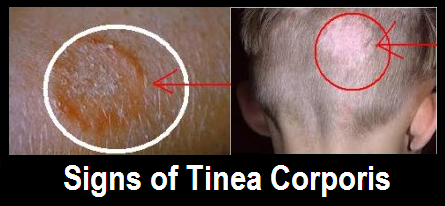Tinea corporis
Tinea corporis is a common dermatological infection caused by a dermatophyte fungus genus trichophyton, which is a parasite responsible for a variety of infections including tinea, ringworm, athlete’s foot, jock itch, etc. Parasitic fungal infections can affect any part of the body, and especially the nails, skin, beard and scalp, as dermatophytes often feed and grow exclusively on dead body tissue (the nails, hair, and the epidermis); However, in severe conditions dermatophytes may affect the dermis.[2][3][4]
Tinea corporis (ringworm infection, التهاب الثعلبة الجرثومي) is a common contagious dermatophyte infection characterized by either inflammatory or noninflammatory itchy annular lesions, which can occur in people of all ages, especially young adults living in warm moist areas.
A number of factors contribute to the high levels of dermatophyte infection within various population groups, Particular dermatophyte infection risk behaviors within a population group include bad living standards, poor personal hygiene, and living in moist rural areas, as dermatophytes often grow over warm wet surfaces such as clothing tools in resorts or clubs, combs, shower floors and walls, pool surfaces, etc.
Tinea corporis is a highly contagious disease that spread by direct contact with an infected person, especially if the person is dirty or injured (nail bed injuries, and invisible micro skin injuries), and by indirect contact with an infected person’s belongings or environment.[1]
Symptoms
Incubation period of ringworm infection vary, depending on the pathogenic organism infecting the body, initial symptoms start to show after an incubation period of 10 to 14 days for Tinea capitis, or 4 to 10 days for Tinea corporis and Tinea cruris; However, the incubation period of Tinea pedis is unknown.[6][7][8]
Itching rash, hair loss and nail discoloration are the most common symptoms of tinea infection, the disease starts with small raised pink spots over small areas of hyperemic skin, spots develop slowly, over a few days into itchy round rings (with red, pink, and pale colors). Moreover, hair loss occurs in areas of the infection, especially if the affected area is hairy (beard, skull, groin, etc.).
Frequently, acute ringworm infection presents as itchy inflamed red patches, especially in the groin area (jock itch), and between the toes; however, colorless itchy patches are also common (on the scalp, or in a man’s beard).
Diagnosis
A skin biopsy is the golden standard examination for tinea corporis.
The KOH Test (potassium hydroxide preparation) for tinea corporis is a second choice examination, it is a quick, and economic fungal test to differentiate dermatophytes symptoms from other dermatological disorders, especially if you live in a city.[9][10][11]
KOH preparation
Scraping samples are covered with 20% potassium hydroxide, and are placed directly onto a microscope slide to identify the pathogenic organisms, if fungal elements are seen, then a fungus is the likely the cause of infection.
Treatment
Lifestyle modification
Lifestyle modification to reduce stress, and improve subjective quality of life; Moreover, incorporating hygienic considerations is a great lifestyle approach to treating yourself, patients are encouraged to bath at least two times per day, to wash their skin with soap, to always use clean towels, and to change their socks and underwear repeatedly.[1][12]
Medicinal treatment
Antifungal creams (miconazole, or Oxiconazole nitrate 1%) are often used to treat dermatophyte infections of the skin, scalp and nails.[14][15][16]
Apply the antifungals on dry clean skin, and keep on the treatment, dermatophyte infections usually heal in 4 to 6 weeks. No need for oral drugs.[13]
Hydrocortisone creams are also used to reduce the itching that often accompanies dermatophyte infections related to fungal growth…
Natural treatment
Smash an amount of onion or onion seeds into a fine paste, then extract the liquid from them by using a piece of gauze.
Taken one tablespoon of onion extract in the morning and another tablespoon in the evening before going to bed, repeat this procedure on daily basis, and keep on the treatment until achieving a full cure.
Onion extract works wonders in areas of immunity and skin repair, as it is a natural antibiotic proven effective in treating various ailments, such as anemia, and tinea corporis… [1]
Sunbathing is an alternative orthodox treatment for tinea corporis, simply dive in the sea then take sunbathe to dry, it is also an effective way to empower vitamin D production.
References

Verified by: Dr.Diab (August 10, 2018)
Citation: Dr.Diab. (August 10, 2018). Tinea Corporis Symptoms Diagnosis and Treatment. Medcoi Journal of Medicine, 14(2). urn:medcoi:article1993.














There are no comments yet
Or use one of these social networks